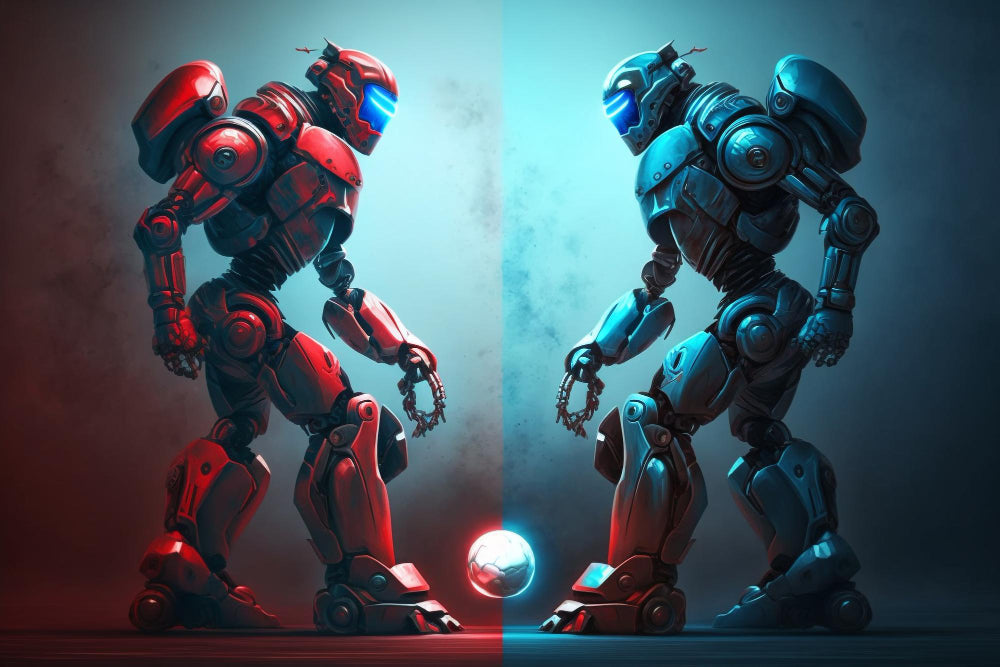Revolutionizing Design: How 3D Modeling is Shaping Multiple Industries

In a nutshell, 3D modeling is the process of creating digital representations of objects or environments in three dimensions. It involves the use of specialized software and tools to construct detailed virtual models that closely resemble real-world objects. These models are built using a combination of geometric shapes, textures, and materials, allowing for a realistic and immersive representation of the design.
The evolution of 3D modeling has been remarkable. Initially, 3D modeling was a complex and time-consuming process limited to specialized professionals. However, the capabilities of 3D modeling have expanded, allowing for more intricate and detailed designs, realistic simulations, and improved collaboration among designers and stakeholders.
I. Importance of design revolution in industries
The design revolution facilitated by 3D modeling has had a profound impact on industries worldwide. It has brought about a fundamental shift in how products, structures, and services are conceptualized, developed, and presented. By embracing 3D modeling, industries have gained the ability to innovate, streamline processes, enhance product quality, and deliver superior user experiences.
In the past, design processes relied heavily on 2D drawings and physical prototypes. These methods often resulted in challenges such as miscommunication, design limitations, and high costs. However, with the design revolution enabled by 3D modeling has become a catalyst for progress and competitiveness in today's fast-paced business landscape. Industries that embrace this revolution gain a competitive edge by creating innovative designs, reducing time to market, and enhancing customer satisfaction. In a world where design plays a crucial role in attracting and retaining customers, the impact of the design revolution cannot be underestimated.
II. Evolution of 3D Modeling
Over the years, 3D modeling technology has undergone significant advancements, enabling designers to achieve greater levels of precision, realism, and efficiency. Initially, 3D modeling was a complex and time-consuming process limited to specialized professionals. However, with the advent of user-friendly software and improved hardware capabilities, it has become more accessible to a broader range of industries and individuals.
a. Advancements in 3D modeling techniques
Advancements in 3D modeling techniques have revolutionized the way objects and environments are created and visualized. From traditional wireframe models to more sophisticated techniques like surface modeling, solid modeling, and parametric modeling, designers now have a wide range of tools and methods at their disposal. These techniques allow for more accurate and detailed representations, enabling designers to bring their ideas to life with precision and realism.

b. Impact of 3D modeling advancements on industries
The advancements in 3D modeling have had a profound impact on industries across the board. In architecture and construction, for instance, 3D modeling has revolutionized the design and visualization process, facilitating better communication among stakeholders and enabling more accurate planning and construction. In manufacturing, the ability to create virtual prototypes and perform simulations has resulted in improved product quality, reduced costs, and faster time to market. Similarly, industries such as healthcare, automotive, and entertainment have benefited immensely from the advancements in 3D modeling, witnessing increased efficiency, innovation, and overall success.
By embracing the continuous advancements in 3D modeling techniques, industries have been able to unlock new levels of creativity, efficiency, and competitiveness. The impact of these advancements on industries is far-reaching, transforming the way products are designed, manufactured, and experienced by end-users.
In the next sections, we will delve deeper into the various applications of 3D modeling in industries, the impact on manufacturing processes, the potential for design innovation, and the future outlook for this groundbreaking technology.
III. Shaping Industries through 3D Modeling
a. Industries Embracing 3D Modeling
The impact of 3D modeling can be witnessed across a wide range of industries that have fully embraced this revolutionary technology. Let's explore some of the sectors where 3D modeling has found extensive use:
i. Architecture and Construction:
Architects and designers rely on 3D modeling to visualize and communicate their ideas effectively. It allows them to create detailed models of buildings, structures, and interiors, enabling clients and stakeholders to gain a comprehensive understanding of the proposed designs.
ii. Manufacturing and Engineering:
The manufacturing industry has greatly benefited from 3D modeling. It enables engineers to create accurate prototypes, simulate production processes, and identify potential design flaws before investing in physical production. 3D modeling facilitates streamlined manufacturing operations, reducing costs and optimizing efficiency.
iii. Entertainment and Media:
In the realm of entertainment, 3D modeling has revolutionized the creation of movies, video games, and animations. It allows for the development of realistic characters, immersive environments, and breathtaking special effects, enhancing the overall visual experience for audiences worldwide.
iv. Healthcare and Medical Devices:
The healthcare industry leverages 3D modeling to improve patient care and medical device development. Surgeons use 3D models for pre-surgical planning, enabling precise visualization of complex anatomical structures. Customized medical implants and prosthetics can also be designed using 3D modeling techniques.
v. Automotive and Aerospace:
In the automotive and aerospace sectors, 3D modeling plays a vital role in the design and development of vehicles and aircraft. It facilitates the creation of intricate components, aerodynamic simulations, and crash testing, leading to safer and more efficient transportation solutions.
b. Design Transformation with 3D Modeling
3D modeling has fundamentally transformed the way designers approach their work, bringing about a significant design revolution. Here are some key aspects of design transformation enabled by 3D modeling:
i. Visualization and Communication:
3D modeling allows designers to visualize their ideas in a realistic and immersive manner. They can create virtual representations of their designs, enabling clients and stakeholders to grasp the concept more easily. This enhances communication, leading to better collaboration and alignment of design goals.
ii. Design Process:
With 3D modeling, designers can iterate on their designs quickly and efficiently. They can make modifications, test different variations, and evaluate the visual and functional aspects of their creations in a virtual environment. This iterative design process helps refine and improve designs before moving into physical production.
iii. Rapid Prototyping:
3D modeling enables the rapid prototyping of designs, reducing the time and cost involved in traditional prototyping methods. Designers can convert their digital models into physical prototypes using 3D printing or other fabrication techniques. This allows for thorough testing, evaluation, and validation of designs before mass production.
iv. Design Exploration and Creativity:
3D modeling technology encourages designers to explore new creative possibilities. It enables them to experiment with different shapes, materials, and configurations, pushing the boundaries of traditional design constraints. This fosters innovation and drives the development of unique and visionary designs.
c. Industries Influenced by 3D Modeling
The influence of 3D modeling extends to numerous industries, demonstrating its broad impact on various sectors. Here are some additional industries that have been significantly influenced by 3D modeling:
i. Fashion and Apparel:
The fashion industry employs 3D modeling to create virtual fashion shows, design virtual garments, and streamline the production process. Virtual prototyping and digital sampling reduce waste, improve design accuracy, and accelerate the time to market.
ii. Interior Design and Real Estate:
3D modeling enables interior designers to create realistic renderings of spaces, allowing clients to envision the final outcome. Real estate professionals utilize 3D models to showcase properties, providing virtual tours that enhance marketing efforts and aid in the decision-making process.
iii. Gaming and Virtual Reality:
The gaming industry heavily relies on 3D modeling to bring virtual worlds and characters to life. 3D models serve as the foundation for creating immersive gameplay experiences. Virtual reality (VR) applications leverage 3D modeling to transport users into virtual environments for various purposes, including training, education, and entertainment.
iv. Advertising and Marketing:
3D modeling enhances advertising and marketing campaigns by creating visually captivating and engaging content. It enables the creation of lifelike product renderings, animated commercials, and interactive digital experiences that grab consumers' attention and drive brand engagement.
The impact of 3D modeling extends far and wide, touching numerous industries and transforming the way design is approached and executed. From architecture and manufacturing to entertainment and healthcare, the adoption of 3D modeling continues to shape and revolutionize various sectors, paving the way for innovation, efficiency, and enhanced creativity.

IV. Applications of 3D Modeling in Industries
a. Benefits of 3D modeling in design
3D modeling offers a multitude of benefits in the design process. Firstly, it provides designers with a realistic visualization of their ideas, allowing them to explore different concepts and iterate on designs before committing to physical prototypes. This ability to visualize designs in three dimensions helps in identifying potential issues and making necessary adjustments early on, resulting in improved design quality.
Moreover, 3D modeling enables designers to communicate their ideas effectively. Clients, stakeholders, and team members can better understand the design intent through detailed and accurate 3D representations. This leads to smoother collaboration, reduced misinterpretation, and enhanced decision-making throughout the design phase.
b. Enhanced product development with 3D modeling
The integration of 3D modeling in product development revolutionizes the entire process. It enables rapid prototyping, allowing designers to create physical models quickly and efficiently. By using 3D printers or other additive manufacturing techniques, prototypes can be produced with precise accuracy, saving time and costs associated with traditional prototyping methods.
Furthermore, 3D modeling facilitates thorough testing and evaluation of product designs. Virtual simulations can be performed to analyze factors such as structural integrity, ergonomics, and functionality. This helps in identifying potential design flaws, optimizing product performance, and ensuring a superior end-user experience.
c. Design optimization through 3D modeling
Design optimization is a crucial aspect of any industry, and 3D modeling plays a vital role in this process. By creating virtual prototypes, designers can evaluate various design iterations and assess their performance in real-world scenarios. This iterative design process enables fine-tuning of product designs, enhancing their efficiency, reliability, and overall quality.
Additionally, 3D modeling allows for the exploration of alternative design options and materials. By digitally testing different configurations, materials, and manufacturing techniques, designers can identify the optimal combination that meets specific requirements, leading to cost savings and improved sustainability.
V. Impact of 3D Modeling on Manufacturing
a. Revolutionizing manufacturing processes
3D modeling has brought about a revolution in manufacturing processes. Traditional manufacturing methods often involve multiple steps, including manual tooling and molding. However, with the advent of 3D modeling, these processes can be streamlined and made more efficient.
By utilizing 3D models, manufacturers can employ technologies such as additive manufacturing (3D printing) to directly produce complex parts or components, eliminating the need for expensive tooling. This not only reduces production time but also opens up new possibilities for intricate designs and customization.
b. Efficiency improvements with 3D modeling
The implementation of 3D modeling in manufacturing greatly improves efficiency. With detailed 3D models, manufacturers can accurately plan production workflows, optimize material usage, and minimize wastage. This level of precision helps in achieving higher productivity and reducing costs.
Furthermore, 3D modeling allows for virtual assembly simulations, enabling manufacturers to identify any potential clashes or interferences early on. This proactive approach minimizes errors during the actual assembly process and ensures a smoother production flow.
c. Cost and time savings in manufacturing
The integration of 3D modeling in manufacturing processes brings significant cost and time savings. Traditional manufacturing often requires the creation of physical prototypes, which can be expensive and time-consuming. With 3D modeling, virtual prototyping eliminates the need for physical iterations, reducing both material and labor costs.
Moreover, 3D modeling enables manufacturers to identify design issues or improvements in the early stages, avoiding costly modifications or production delays later on. The ability to simulate and optimize manufacturing processes through 3D modeling helps streamline operations, shorten lead times, and deliver products to market faster.
VI. Design Innovation with 3D Modeling
a. How 3D modeling fosters innovation
3D modeling has become a catalyst for design innovation, offering designers unprecedented freedom and flexibility in their creative process. By enabling the visualization of complex designs in a virtual environment, 3D modeling allows for more experimentation and exploration of ideas. Designers can easily manipulate and refine their concepts, quickly iterating and refining until they achieve the desired outcome. The ability to view designs from different angles and perspectives, as well as simulate lighting and materials, empowers designers to make informed decisions and push the boundaries of what is possible.
b. Digital design revolution in industries
The advent of 3D modeling has sparked a digital design revolution across various industries. Traditional design methods, which relied heavily on physical prototypes and manual processes, have been replaced by digital workflows that leverage 3D modeling. This revolution has democratized design, making it more accessible and efficient for businesses of all sizes. Industries such as architecture, interior design, and product development have witnessed a significant shift towards digital design processes, resulting in enhanced collaboration, improved efficiency, and accelerated time to market.

c. Trends in design enabled by 3D modeling
3D modeling has given rise to exciting design trends that have transformed industries. One such trend is parametric design, which utilizes algorithms to generate and manipulate 3D models based on predefined parameters. This approach allows for the creation of intricate and complex designs that were previously challenging to achieve. Additionally, the integration of 3D modeling with generative design techniques has enabled the exploration of innovative and optimized design solutions. By leveraging artificial intelligence and algorithms, designers can generate multiple design options, evaluating their performance and selecting the most optimal solution.
VII. Future Outlook and Conclusion
The future of 3D modeling holds tremendous potential for advancements that will further revolutionize industries. One such area is the integration of 3D modeling with augmented reality (AR) and virtual reality (VR) technologies. This combination will enable designers to visualize and experience their designs in immersive virtual environments, enhancing the design process and facilitating better client engagement.
If you are in need of high-quality 3D models or assets for your projects, look no further than my3dmodels.com. With a vast collection of meticulously crafted 3D models, they offer a wide range of options to suit your specific needs. Whether you are an architect, product designer, or creative professional, my3dmodels.com can provide the resources you require to bring your vision to life. Visit their website today to explore their collection and unlock the full potential of 3D modeling in your industry.
As we look towards the future, the continuous advancements in 3D modeling technology will further shape industries, offering new possibilities and pushing the boundaries of design. The impact of 3D modeling on industries has been profound and far-reaching. It has revolutionized design processes, fostered innovation, and improved productivity. Embrace the power of 3D modeling, stay ahead of the design trends, and witness the positive impact it can have on your industry.
-
Posted in
3d character modeling, 3d model, User expereince




